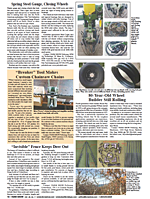SWAT Maps Offer Unique Field Info
 ✖  |
Canadian technology company Croptimistic offers SWAT (Soil, Water and Topography) maps and SWAT Boxes and associated software to make them. SWAT maps integrate the soil, water and topography in fields into a single field map. They use electroconductivity (EC) sensing and RTK elevation capture or LiDAR. They provide field characteristics for use with variable rate fertilizer, seed, soil amendment, pesticide, or precision water management decisions.
“These layers are fundamental to understanding the unchanging, stable aspects of a field,” says Evan MacDonald, Croptimistic Technology. “Other maps, such as yield maps, can be impacted by hundreds of different variables. Our maps focus on the soil, not the crop in season, seeding rates or starter fertilizer.”
The SWAT Box is key to creating a SWAT map with SWAT Records software. It can be mounted on a truck, off-road vehicle, or farm equipment to collect needed data. The SWAT Box is mounted just above the soil, as opposed to traditional EC sleds, which drag across the field, reducing potential maintenance.
SWAT mapping is typically done by a crop consultant or by a Croptimistic staff member. Currently, the company has around 70 on staff, mostly in western Canada.
“Once a farmer sees his SWAT field maps, he understands how they can be used,” says MacDonald. “Once a map is created, it doesn’t have to be redone unless drain tiles have been installed or soil has been moved.”
One way SWAT maps are used is to break fields into zones for soil sampling and precision seeding or application rates. Zones are based on water movement, elevation, organic matter and soil types.
“Typically, every field is broken into about five zones,” says MacDonald. “SWAT field mapping generally falls in the $11 to $14 per acre range, depending on size and geography. It usually includes EC mapping, zone creation and initial soil sampling.”
MacDonald points out that without the ability to address variability within a field, the SWAT Map has limited value. “If producers have variable rate seeding, spraying and nutrient application capability, we can provide practical solutions,” he says.
The zones can also be used with soil moisture sensors and a software tool called SWAT Water. It utilizes several deep soil texture samples and sensor data to model the available soil moisture supply. Weekly water maps can then be developed for irrigation management or side dressing.
“Our main target for the use of the SWAT Maps is the producer,” says MacDonald. “To deliver them, we have licensed the technology to around 60 licensed agronomists or consultants around the world. They offer the service to clients in the U.S., Canada, Australia and South Africa.”
Contact: FARM SHOW Followup, Croptimistic Technology Inc., 502C 47th St. E, Saskatoon, Sask., Canada S7K 4L3 (ph 800-421-4099; support@swatmaps.com; www.swatmaps.com).

Click here to download page story appeared in.
Click here to read entire issue
SWAT Maps Offer Unique Field Info CROPS New Techniques Canadian technology company Croptimistic offers SWAT Soil Water and Topography maps and SWAT Boxes and associated software to make them SWAT maps integrate the soil water and topography in fields into a single field map They use electroconductivity EC sensing and RTK elevation capture or LiDAR They provide field characteristics for use with variable rate fertilizer seed soil amendment pesticide or precision water management decisions “These layers are fundamental to understanding the unchanging stable aspects of a field ” says Evan MacDonald Croptimistic Technology “Other maps such as yield maps can be impacted by hundreds of different variables Our maps focus on the soil not the crop in season seeding rates or starter fertilizer ” The SWAT Box is key to creating a SWAT map with SWAT Records software It can be mounted on a truck off-road vehicle or farm equipment to collect needed data The SWAT Box is mounted just above the soil as opposed to traditional EC sleds which drag across the field reducing potential maintenance SWAT mapping is typically done by a crop consultant or by a Croptimistic staff member Currently the company has around 70 on staff mostly in western Canada “Once a farmer sees his SWAT field maps he understands how they can be used ” says MacDonald “Once a map is created it doesn’t have to be redone unless drain tiles have been installed or soil has been moved ” One way SWAT maps are used is to break fields into zones for soil sampling and precision seeding or application rates Zones are based on water movement elevation organic matter and soil types “Typically every field is broken into about five zones ” says MacDonald “SWAT field mapping generally falls in the $11 to $14 per acre range depending on size and geography It usually includes EC mapping zone creation and initial soil sampling ” MacDonald points out that without the ability to address variability within a field the SWAT Map has limited value “If producers have variable rate seeding spraying and nutrient application capability we can provide practical solutions ” he says The zones can also be used with soil moisture sensors and a software tool called SWAT Water It utilizes several deep soil texture samples and sensor data to model the available soil moisture supply Weekly water maps can then be developed for irrigation management or side dressing “Our main target for the use of the SWAT Maps is the producer ” says MacDonald “To deliver them we have licensed the technology to around 60 licensed agronomists or consultants around the world They offer the service to clients in the U S Canada Australia and South Africa ” Contact: FARM SHOW Followup Croptimistic Technology Inc 502C 47th St E Saskatoon Sask Canada S7K 4L3 ph 800-421-4099; support@swatmaps com; www swatmaps com
To read the rest of this story, download this issue below or click
here to register with your account number.







